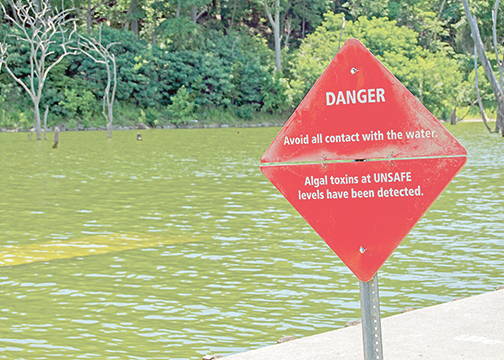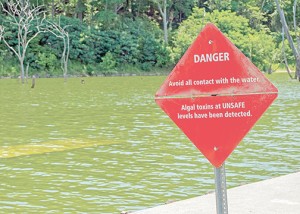

Editor
Harsha Lake in East Fork State Park is under a health advisory after harmful algal blooms were found in the lake.
The main beach is under a recreational health advisory and the campground beach is under a elevated recreational public health advisory, said Keith Robinson, Clermont County Public Health communication coordinator.
The condition could last awhile, depending on the weather. The best chance of the water being safe again is for the weather to cool off and be cloudy rather than sunny, Robinson said.
Currently, there is no advisory on Stonelick Lake or the Clermont County section of the Ohio River, Robinson said.
A combination of hot, sunny days, dry weather and an excess of nutrients in the lake cause HABs to form. This typically occurs in the middle of the summer but is not surprising this time of year because of the weather lately, Robinson said.
The blooms, caused by a type of blue-green algae, creates toxins called microcystins. The organisms are normally found in bodies of water but are dangerous when they reach a level higher than 20 parts per billion, according to a press release from CCPH.
A recreational advisory is put out when levels are between 6 and 20 parts per billion and an elevated advisory is put out when levels are above 20 parts per billion, Robinson said.
“The nutrients usually come from excess fertilizers from nearby areas that enter the lake and nearby streams when it rains,” the press release states.
A June 9 water sample that the Ohio Environmental Protection Agency took showed levels at three locations were higher than 50 parts per billion. A sample taken on June 15 showed levels at the campground beach was 50 parts per billion but at the public beach were 8.5 parts per billion.
“Ohio has seen an increase in the number of algae blooms on lakes and rivers over the last few years,” a press release states.
When there is an algae bloom, the water may look blue or green or look like spilled paint, it may have a thin film on the top or it may have a bad small. HAB toxins do not have to be swallowed to cause illness, just touching the water with exposed skin can make someone sick.
Symptoms of exposure include skin rashes, hives or blisters, runny eyes and nose, sore throat, asthma-like symptoms, diarrhea and vomiting, abdominal pain, dizziness, weakness or difficulty breathing. Anyone experiencing symptoms who has been swimming in Harsha Lake should call a physician.
At both East Fork and Stonelick parks, white signs are posted describing what the blooms look like. When toxins reach a certain amount, orange warning signs are posted. When toxins reach the danger level, red warning signs are posted, according to a press release from the county.
The county Water Resources Department is increasing the frequency of its sampling and testing for cyanobacteria at Harsha Lake in response to the state requiring that public water systems that use surface water must test on a regular basis, according to the release.
The department began sampling once a week on June 1, with plans to sample more than that if blooms are found. The reporting was voluntary in the past. The county will send reports to the Ohio EPA.
On an average day about 20 percent of the water Clermont County uses is from Harsha Lake, which is treated at the Bob McEwen Water Treatment Plant.
To remove or prevent algal toxins, the plant’s intake structure draws water from three different levels in the lake. Algal blooms form near the surface, so water drawn from deeper in the lake can avoid the blooms. In addition, the plant does a treatment to remove particles from the water and disinfects the water with chlorine, according to a release.
For more information from CCPH, go to www.ccphohio.org. To read more on beach safety, go to publicapps.odh.ohio.gov/BeachGuardPublic/Default.aspx.
